Saint Paul, MN (day 1)

Here is our 18 day trip in map form. This is truly a trip through the heart of America.
We started by walking to the Wabasha Street Caves. Before European settlers arrived in St. Paul in the 1800’s, indigenous tribes used a number of naturally formed caves carved out of the soft St. Peter sandstone by the Mississippi’s rushing waters. In the 1840s investors started mining for silica, key to all glassmaking. When this business died off, they were used to grow mushrooms, than taken over by gangsters who set up a speakeasy during Prohibition. Then the caves were converted to a hotel, but after WWII started they became simply storage places and the structure deteriorated over time. Since the end of the COVID19 pandemic they have become host to a variety of events such as weddings, banquets, swing dancing nights and cave tours.
There were several classic cars in front the entrance to the caves and we see Patty & Craig next to one of them.
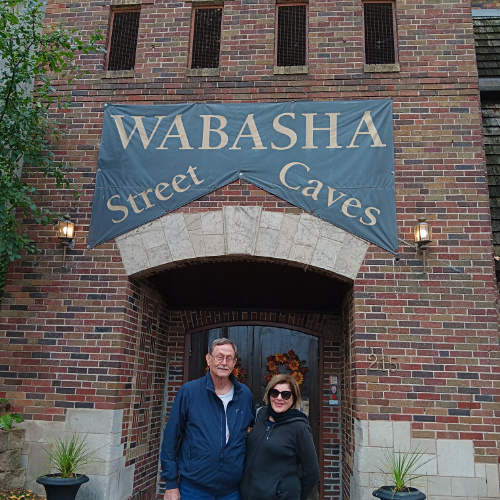
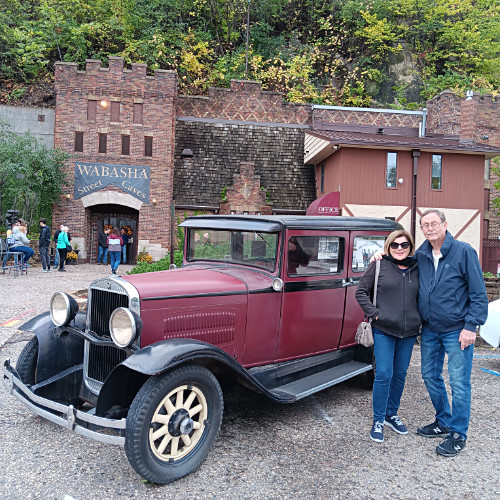
There are seven different caves, but we are only allowed in four of them - the first being outfitted as a dance hall, wedding location, and general-all-round recreation room.
The final picture shows Craig & Patty with the Halloween decorations set up for our visit.


Red Wing, MN


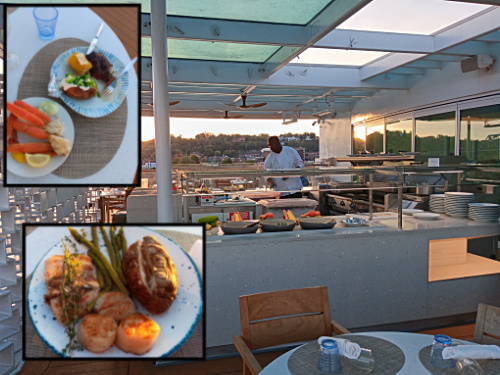
After a morning at the Wabasha Street Caves, we were driven down to the city of Red Wing, where our ship was docked. As you can see from the picture at the top of this page, it has five stories, with a restaurant on the 1st floor and a buffet and outdoor grill on the aft of the 5th floor.
Here we see Patty sitting on the aft area, where an infinity pool is located, while Craig is just in front of her, standing by the port side.
Just in front of them is the outdoor grill, with a couple of dishes that were prepared there. This is where hamburgers, steaks, fish, potatoes, and various vegetables were regularly grilled for every meal. Sure, you could find most things in the buffet inside, but nothing beats grilling some foods.
Red Wing & Wabasha, MN (day 2)

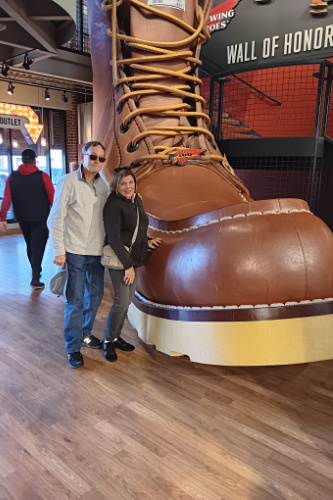
The second day we walked through parts of Red Wing in the morning...including the largest shoe ever made.
Passing the Red Wing statue on our way back to the ship, we boarded a bus for an afternoon visit to the town of Wabasha, downriver about 40 miles.
The Wabasha downtown, while under construction, does house the National Eagle Center.
This part of the country contains the largest concentration of Bald Eagles. They are carnivores, and fish is their almost exclusive diet. The Mississippi provides the ideal climate and environment for these birds.
Only those birds who cannot fly are not released.


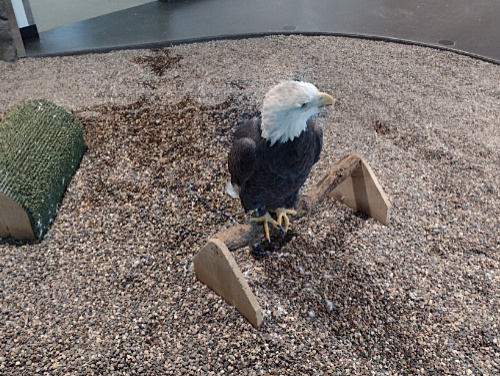
This is Sunday night, our first night cruising the Mississippi. There are 27 locks on the Upper Mississippi - above St. Louis - and levees are used to control the river below that point. From Red Wing, we will be going through 24 of the locks. Below is the first lock and Patty recorded a 30 second video of the experience.

La Crosse, WI (day 3)



The next morning the view above greeted us, as we neared La Crosse, WI. We were on an early morning tour of the town that ended high on the eastern bluffs overlooking the Mississippi Basin. The bus had to take an alternate approach, as the normal drive up was too steep for us.
From here we could see the extremely rich area that native Americans first settled and farmers so valued.
We returned to the shore area and walked to the Riverside International Friendship Gardens, near where we docked.
This is a very peaceful and pretty area that was broken up into representations of several different countries around the world. Patty is seen in an area representing Scandinavia.
Finally, we see Craig heading back to the ship along the wide waterfront sidewalk.



Returning to the ship, we gathered in the Explorers Lounge on deck 2.
The evening started off with a demonstration of how to make a Mint Julep...relatively few ingredients, but fairly difficult for a bartender to make. Of course there were samples all around.
Dubuque, IA (day 4)
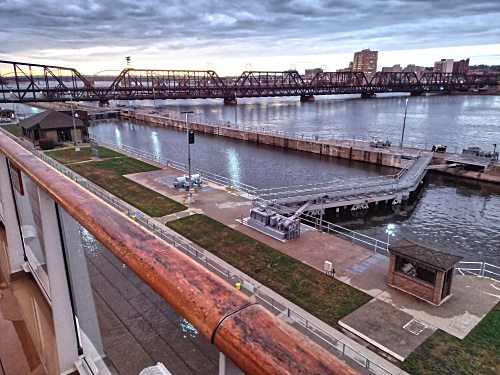


Just before we docked in Dubuque, IA we went through this lock/train bridge. We had to wait until trains crossed before the bridge would swing to let us through.
Upon docking - see picture at the top of this page - we got off the ship and visited a museum near the area. There were many exhibits across two buildings, including several aquariums.
Back near the dock, we took a bus into Dubuque, getting off at a stop on the north end of town. Walking south we got this view of Main Street USA.
We saw on a map that there was a funicular that might give us a view of the bluffs overlooking the Mississippi. It was a free ride to the top - for us at least - and the view was pretty spectacular. Our friend Diane was travelling with us and accompanied us on this trek through town and on the funicular.
Returning down, we walked about a mile back to the ship and thus ended our stay in Dubuque, IA.




Davenport, IA & Moline, IL (day 5)
We docked in Davenport, but immediately bussed across the Mississippi to Moline, IL. This is the home of John Deere machinery. Our tour took us through a couple of Deere and descendent homes, then to a presentation showroom where many Deere machines - old and new - were available for public inspection and climbing over.
Below note Craig walking by the earliest motorized Deere tractor and Patty standing by the forks of a huge, modern harvester model.

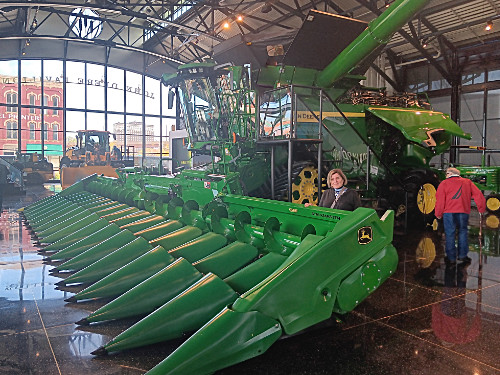

Here Craig is sitting in the cab of a modern heavy tractor.


Returning to our cabin you can see Craig working at the desk. This is vacation, right???
Burlington, IA (day 6)
Burlington means another tour of the city and we stop first at the very small Mosquito Park, overlooking the Mississippi. We see here a tug moving a number of barges down the Mississippi. We frequently saw 21 barges, grouped 3 across and 7 deep being moved both up and down the river, however, there also were much larger groupings.




Later the bus stopped at Snake Alley - the curviest street in the U.S. I thought Lombard Street in San Francisco had this title, but - after walking the length of Snake Alley - I agree with the claim.
Back on board the ship just after noon, we decided on lunch at the buffet. Of course the desert options - gelato each day - interested Craig.



A harpist was provided for entertainment and - since Patty plays her own harp - we made sure to attend both evening performances.
Hannibal, MO (day 7)



Hannibal - the home of Mark Twain and many of his stories.
We first went to the Twain household, then walked down Main Street and back to the Viking Mississippi.
Craig got a tee shirt with the same saying on it as the banner shown here.

Finally, a look down Main Street toward the lighthouse described in several Mark Twain stories.
We said goodbye to Hannibal in the afternoon... Craig, Patty, & Diane - dinner at the restaurant on Deck 1.

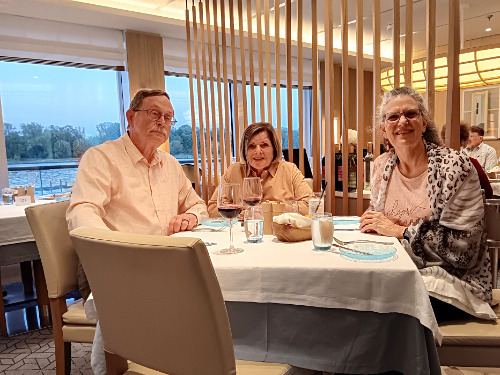
St. Louis, MO (day 8)



The St Louis Gateway Arch is huge and majestic. We went through the museum located under ground, directly below Patty and learned much St. Louis history.
Our tour took us to Scott Joplin's residence where he lived for a couple of years while in St Louis writing a number of his rags. His home was a single, small room that was rented with meals included. This was a working class residence and there was an immense difference between how the 'landed' lived and simple working people.


Scott Joplin's work spanned decades, for 1890 - 1917. He was unusual in that he was classically trained and wrote his music down. That was fortunate because, while he is considered the 'father of Ragtime', he was almost totally forgotten until the movie 'The Sting' was released in 1973. It was only after that time that his opera - Treemonisha - was first produced and his place in Ragtime secured.
Part of our tour included a performance by Maurice, a local musician and musicologist - he was excellent and helped all of us understand how Ragtime music evolved and influenced the music that came after it - jazz, blues, and bebop. It turned out the musicians who played on the ship that night also knew and respected Maurice.
The video below comes from the evening show and Patty was so taken by the singer she recorded one of her songs.

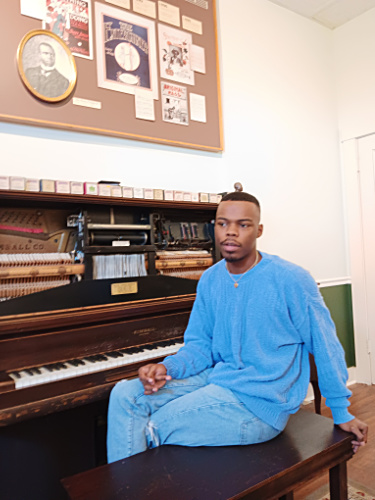
Cruising the Mississippi (day 9)

This was the only day of our cruise where we didn't have some city to visit.
We started with the sunrise and took a day-and-a-half to get from St Louis to Memphis.
Along the way the Ohio River joined up with the Mississippi. You can tell from the picture below because the Mississippi is very muddy and the Ohio is relatively clean water. This is because the Mississippi travels through deltas and carries an enormous amount of silt along with it, while the Ohio is a much more traditional river, running through gorges and mountains.
It is also true that the Ohio carries quite a bit more water than does the Mississippi, so the combination becomes much wider as it travels south.

Memphis, TN (day 10)

For the traveller Memphis is known for Graceland and for its music and we visited both.
Here is Patty getting ready to enter the original mansion, where we saw all the rooms Elvis enjoyed, displayed with all the original furnishings - everything is kept up but nothing remodeled. In addition to the mansion there was an area that reminded us of an Elvis Disneyland. Many of his cars were displayed along with films and other Elvis items. Different stores were available where everything Elvis was on sale.
Our bus than dropped us off at the Peabody Hotel. This is where Danielle and Andy stayed earlier this year and it is famous for the ducks that live there and inhabit the indoor fountain near the registration desk.
Of course Patty had to get near the ducks and we both went to the roof, where the ducks were kept when not on duty in the lobby.


Beale Street is the commercial 'Home of the Blues" and we walked along it until we got to BB King's place. There we went in to have a lunch bite and listen to Blues.




Yes, Blues is played all day long, as well as in the nighttime here in Blues City.
Well before the night we had to say goodbye to Memphis. Here we see the Mississippi River as we leave downtown behind.

Greenville, MS (day 11)

Greenville is more than a night's distance, at the speed we were floating down the river, so we saw another sunrise before we came to our docking area.
Most of our tours visited well kept mansions, but that's not the way the average person lived. Below we saw some more common homes. Even these were much above the shacks we sometimes came across.

When we arrived, there wasn't much to see - we docked in the trees, with only a dusty road having been carved out of the forest. Then we climbed the bank to our busses and made our way to Greensville - 45 minutes away.


The bus took us to a hall where the Steve Azar band entertained us and we got a big Delta sized meal.


Vicksburg, MS (day 12)



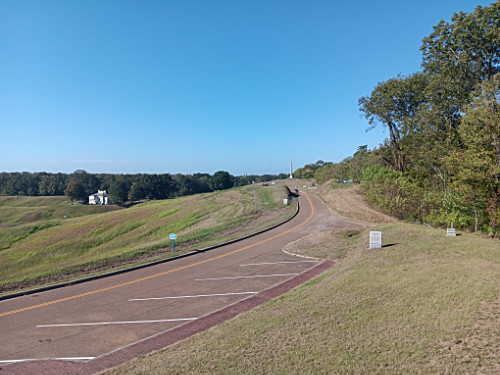

Vicksburg is the site of a turning point in the Civil War. This city controlled access to the Mississippi and the successful siege yielded this control to the Union forces under General U.S. Grant.
The map shows the siege line to the north and east, while the picture on the right shows one of the battlefields 160 years later. Both Union and Confederate positions are marked and they are uncomfortably close to each other.
The U.S.S. Cairo Museum contains the remains of that ironclad warrior that patrolled the Mississippi to the west, preventing supplies from reaching Vicksburg during the siege.
Craig & Patty are shown standing near the U.S.S. Cairo and give you an idea of its immense size. The Monitor & Merrimack fought the Battle of Hampton Bay in the east, marking the first fight between two ironclad vessels, but others were used by the Union to control the Mississippi.



Vicksburg is also home to a National Cemetery housing soldiers from several wars.
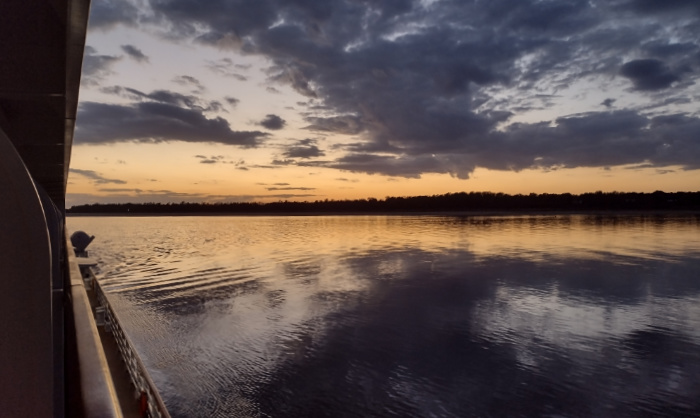
Leaving Vicksburg, we experienced another fantastic sunset on the Mississippi.
Natchez, MS (day 13)
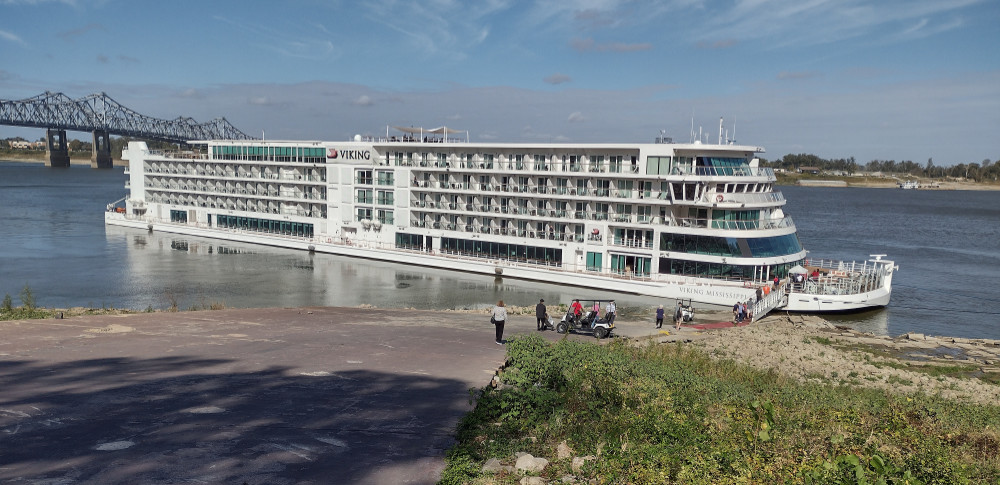
This steep hill leading up to Natchez demonstrates just how low the Mississippi is this time of year. Electric carts were available for those who couldn't walk.

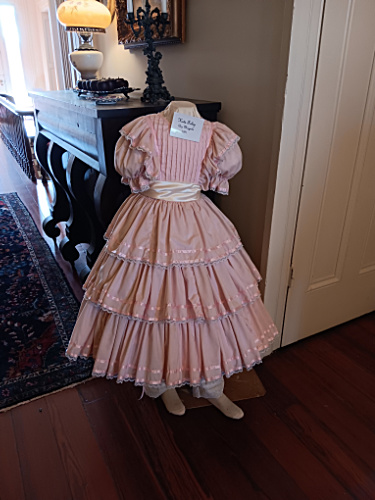
Patty & Diane welcome the fresh air atop the bluff overlooking the river, while the tour of the required mansion showed us just how the women dressed 150 years ago.
Baton Rouge, LA (day 14)


In Baton Rouge we took a walking tour of the city. Near the ship we found the USS Captain Kidd - the only US Military ship to fly the skull-and-crossbones. Of course it currently is severely land-locked.
The city has tried to retain it's old and classical signs. This one is the first Coca Cola neon sign put up in Baton Rouge in the early 20th century.
New Orleans, LA (day 15)

In New Orleans we left the ship and stayed in a hotel for the night.
Our old cruise buddies, Ilene and Steve, were RVing down the Mississippi River at the same time we were and arrived in New Orleans a couple of days before us. They waited and met us the day we arrived.
We spent the time walking the French Quarter and stopped to eat lunch at the Bourbon House on Bourbon Street.

Continuing our walk we see Steve at the Vampire Club - remember it is the day before Halloween - drinking a Vampire cocktail.
The next day we were bussed to the city of Lafayette for two days of tours.
Lafayette, LA (day 16 & 17)



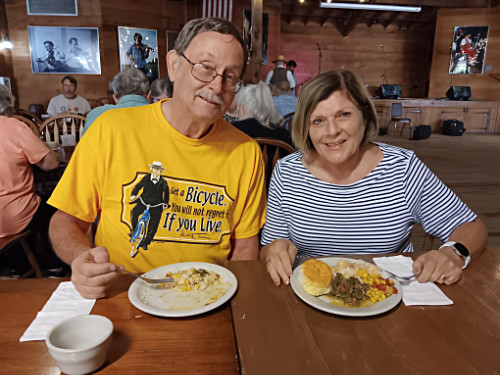
Our bus ride took several hours and stopped at Vermilionville - a recreation of an early French Creole village.
Of course the first thing we did was learn how to make beignets. We have the recipe, but haven't yet tried to recreate them at home.
Then it was on to learning how to weave a small basket - yes we still have Craig's creation sitting somewhere in the kitchen.
After dance lessons - Patty was much better than Craig - it was time for a Creole lunch. We see Craig wearing his Mark Twain t-shirt, with both enjoying the meal.


After lunch, we visited the Martin Accordion company just outside Lafayette.
There are a number of very specific accordion designs and this is a very Cajun type. Patty shows you one here in a part of the workshop where they assemble all their accordions - they ship all over the world.
The tour included a playing session..
It started with one of the family with his accordion - along with their dog, who came over and barked at you if you dared to clap after a performance.
Then the family group joined in and we were treated to an outstanding 'jam session'. This was clearly the 'high point', music-wise, of our entire trip.


The second day we spent on Avery Island - owned by the Tabasco company. It is not really an island, but a slight mountain, compared with the 'barely above sea level' land around it and is somewhat surrounded by water.


Above are the company stores and greenhouse. The Tabasco pepper is a very specific type and all varieties world-wide come from those grown on this island.




After picking and initial processing, the sauce is aged in barrels under salt.
An early Tabasco delivery truck was on display outside.
A royal seal was granted by Queen Elizabeth, as she wanted this spice on her table at all times. King Charles intends to issue a new one.
Finally we were treated to another Cajun dinner, but this one was cooked in front of us and included beignets, salad, main course, and desert. More than any of us could eat.


On our way off the island we were able to stop and visit the Jungle Garden. In this environment a Buddhist Temple was built around a statue of The Buddha and we see two views from the knoll on which the Buddha sits.


The following morning our bus picked us up and took us to the New Orleans airport. Since we were on Delta, we first had to fly east to Atlanta, to fly west to Los Angeles.

 Patty
in front of the Viking Mississippi while docked at our Dubuque, IA stop along
the Mississippi River.
Patty
in front of the Viking Mississippi while docked at our Dubuque, IA stop along
the Mississippi River.